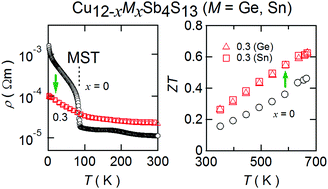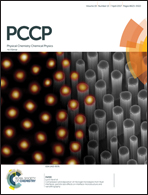Effects of Ge and Sn substitution on the metal–semiconductor transition and thermoelectric properties of Cu12Sb4S13 tetrahedrite†
Abstract
The synthetic tetrahedrites Cu12−yTrySb4S13 (Tr: Mn, Fe, Co, Ni, Zn) have been extensively studied due to interest in metal–semiconductor transition as well as in superior thermoelectric performance. We have prepared Ge- and Sn-bearing tetrahedrites, Cu12−xMxSb4S13 (M = Ge, Sn; x ≤ 0.6), and investigated the effects of the substitutions on the phase transition and the thermoelectric properties. The substitutions of Ge and Sn for Cu suppress the metal–semiconductor transition and increase the electrical resistivity ρ and the positive thermopower S. This finding suggests that the phase transition is prevented by electron doping into the unoccupied states of the valence band. The variations of ρ, S, and magnetic susceptibility for the present systems correspond well with those for the system with Tr = Zn2+, confirming the tetravalent states for Ge and Sn. The substitution of M4+ for Cu1+ decreases the power factor S2/ρ but enhances the dimensionless thermoelectric figure of merit ZT, due to reductions in both the charge carrier contribution and lattice contribution to the thermal conductivity. As a result, ZT has a maximum value of ∼0.65 at 665 K for x = 0.3–0.5 in Cu12−xMxSb4S13 with M = Ge and Sn.



 Please wait while we load your content...
Please wait while we load your content...